1. Why Story Protocol?
Intellectual property (IP) management has long faced problems such as complex structure, high costs, and heavy reliance on centralized intermediaries. With the explosive growth of AI-generated content, these traditional bottlenecks are rapidly evolving into uncontrollable risks, bringing challenges in originality verification, attribution tracing, and large-scale, fair authorization.
Story Protocol proposes a new solution for the digital and AI-driven creative economy:
It uses a programmable IP authorization mechanism, deeply embeds on-chain attribution traceability into the content creation process, and builds flexibly combinable authorization modules, making the re-creation and commercialization of IP more transparent and easier to operate.
Story did not choose to build on top of existing blockchains (such as Ethereum and Solana), but instead took a more forward-looking approach and built its own underlying chain designed specifically for IP. Although this means higher infrastructure costs and promotion barriers, it also brings complete control over the underlying architecture.
For example, Story Protocol core features include:
Accurately track the flow of value in re-creation
Royalties splitting under cross-party collaboration
Natively embed legal terms into license agreements
These mechanisms rely on specialized data structures, customized repetitive computation processes, and the ability to support underlying legal logic - which is exactly what general-purpose public chains are difficult to support natively in their design.
Story does not simply believe in the crypto fundamentalism of code is law, but deeply integrates the binding force and enforceability of the real-world legal system into the system design, striving to achieve a more mature balance between decentralization and legal compliance.

Story Protocol is becoming a key bridge between the real legal system and crypto-native infrastructure. It enables content creators and original IP owners to transition to the blockchain system with greater peace of mind, enabling them to achieve sustainable creation and value recovery in the Web3 world.
This report will explore in depth whether Story Protocol has truly sustainable architectural advantages, and whether these advantages are sufficient to support the complexity and ambition of building its own Layer 1 chain. We will analyze from the following dimensions: market positioning, technical design, real-world application scenarios, AI integration strategies and their potential risks.
2. Towards a new era of AI-driven IP
The rapid development of AI is posing a huge impact on the traditional IP system. The current system mostly relies on offline, law enforcement-based mechanisms, which cannot cope with the new ideas and proprietary results that emerge at the speed of machines. The biggest challenge at the moment is not only who owns the rights, but how to effectively track contributions and fairly distribute value in large-scale creation.
Story Protocol is an infrastructure created to cope with this change. It is committed to achieving transparent traceability and automated incentive distribution mechanisms on the chain, and creating an IP infrastructure native to AI.
In a study covering 1,018 scientists, it was found that scholars who used AI to assist in their research had 44% more breakthroughs in materials science and 39% more patent applications, which clearly demonstrates the important role of AI in promoting knowledge creation.
However, when AI becomes a “co-inventor,” a more complex question arises: when the creation of IP is partially or even completely completed by non-humans, how do we decide who should get the credit and benefits?
Story is designed to answer this question. The tools it provides support accurate attribution in human-machine co-creation scenarios, ensuring that both AI and human creators can get due rewards while contributing value. In a future where AI can autonomously generate content and improve on the achievements of predecessors, whether the original creators are recognized and incentivized will be more important than ever.
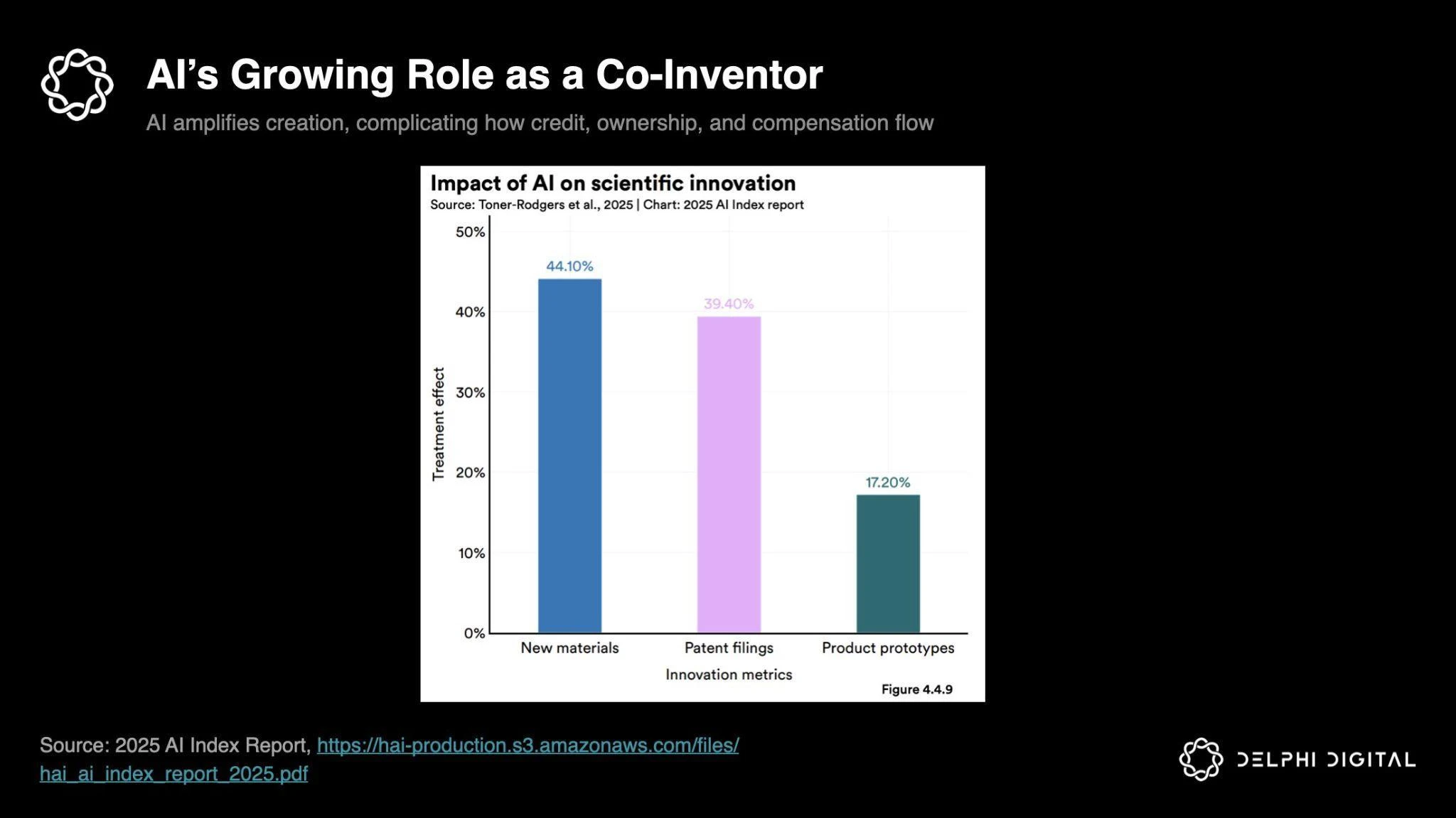
Many believe that the unlimited content production capabilities enabled by AI will marginalize the intellectual property system. If creation is no longer scarce, the enforceable business of copyright and IP will gradually become ineffective. But the future is not set in stone, and we need ownership structures that are oriented to the new content paradigm.
Story Protocol enters a market dominated by three types of IP management systems. Although each has its own advantages, they are unable to meet the needs of AI-native creation for composability and dynamic incentives.
The traditional IP framework relies on centralized registration and post-event accountability, which is clearly not suitable for a high-speed collaborative digital content ecosystem.
DRM systems (such as Adobe and Marlin ) focus on content access control and anti-theft, and basically do not support remix authorization, contribution tracking and automatic royalties.
Although blockchain platforms such as IBMs IPwe tokenize IP assets, they lack key capabilities such as programmable licensing, secondary creation tracking, and royalty distribution.
In contrast, Story provides a more flexible and transparent framework, and supports the flow and monetization of IP in NFT, DeFi and the broader crypto ecosystem through cross-chain interoperability, while still belonging to the Story registration system at the ownership level (logically similar to restaking in DeFi).
Looking to the future, this underlying infrastructure will also lay the foundation for IPFi. Whether it is IP sharding, mortgage lending, or the design of income rights derivatives, all these financial innovations require clear creation ownership and composable protocol structure support, which are exactly the capabilities provided by Story.
Story also prepares for AI native interaction, and its dedicated Agent access mechanism supports programmable interaction between AI and IP assets. Leveraging broader technology trends such as open source, decentralization, and automation, Story Protocol is trying to build long-term infrastructure for the AI-driven intangible asset economy.
2.1 “Ghibliization” and the ethical boundaries of AI art
With the launch of GPT-4 os newly upgraded image generation capabilities, a new round of enthusiasm and controversy about AI art has been set off. This also highlights once again that the underlying infrastructure provided by Story Protocol may become indispensable. Many users are excited about GPT-4 os ability to highly fit iconic styles (such as the classic aesthetics of Studio Ghibli), while the creative industry has expressed deep ethical concerns about this trend. Some voices criticize AIs reproduction of the Ghibli style as plagiarism of the creative spirit, which echoes the position of Ghibli founder Hayao Miyazaki that AI creation is an insult to life.
These heated discussions actually reflect peoples deeper anxieties about intellectual property, the replacement of human creativity, and the ethical boundaries of AI content. The basic capabilities built by Story - making the ownership of works clear at a glance and embedding the terms of use natively into the IP assets themselves - provide creators and IP-based businesses with practical protection tools.
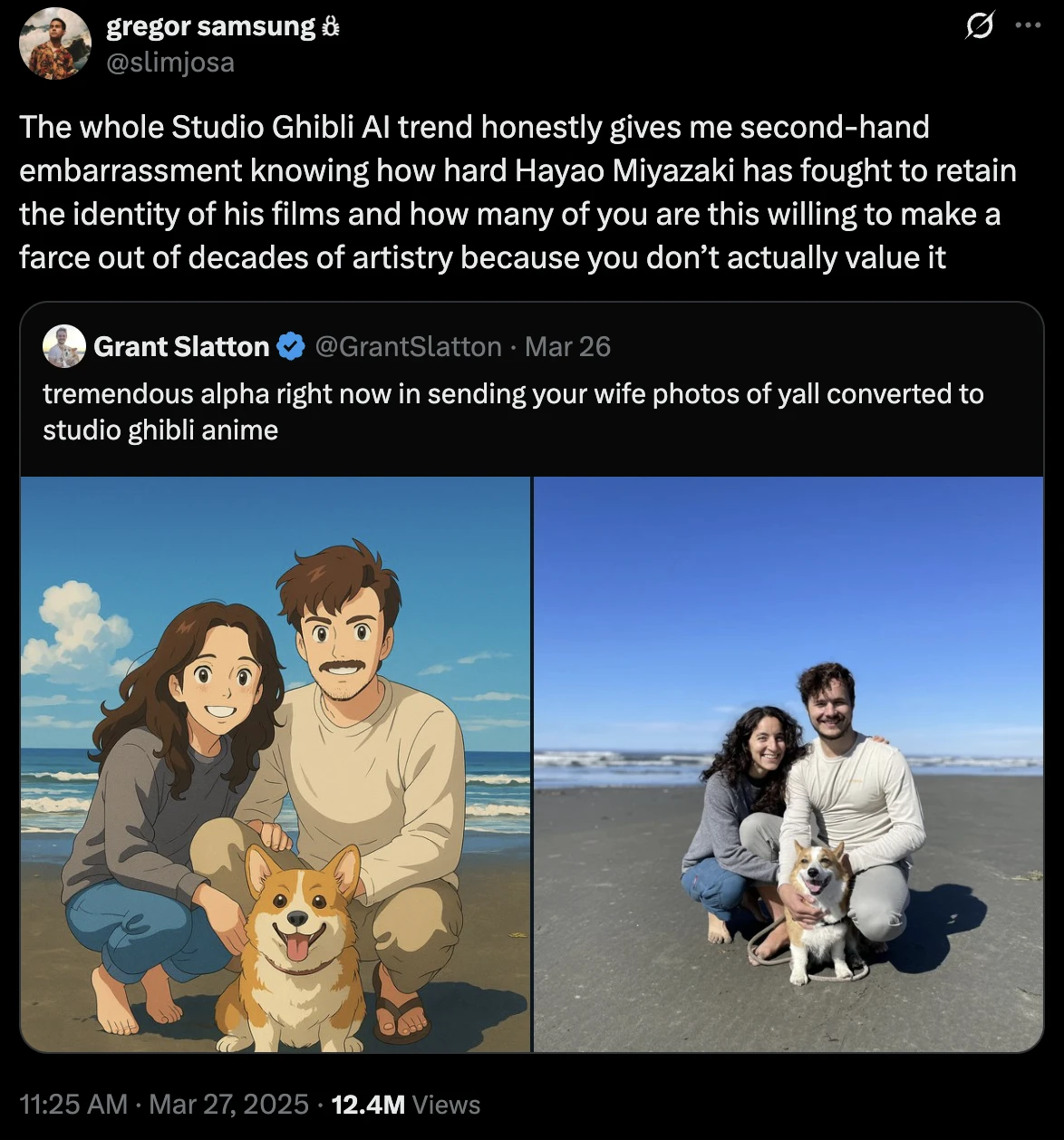
3. Dedicated infrastructure for IP
The core design of Story Protocol is to create a highly interoperable infrastructure that makes rights easy to enforce. It solves the most chaotic and real part of IP licensing from the architectural level: multi-party royalty splitting, overlapping authorization relationships, cross-chain asset circulation, and legal and compliant protocol execution.
To achieve this goal, Story built a set of tightly coupled specialized modules, the key components of which are as follows:
Main Execution Core: An EVM-compatible execution environment optimized for IP transaction scenarios
Intellectual Property Core (IP Core): handles complex licensing processes and royalty transfers, relying on two major mechanisms:
Proof of Creativity (PoC)
Programmable IP Licenses (PIL)
Story Orchestration Service (SOS): Building an interactive bridge between on-chain assets and off-chain legal and financial systems
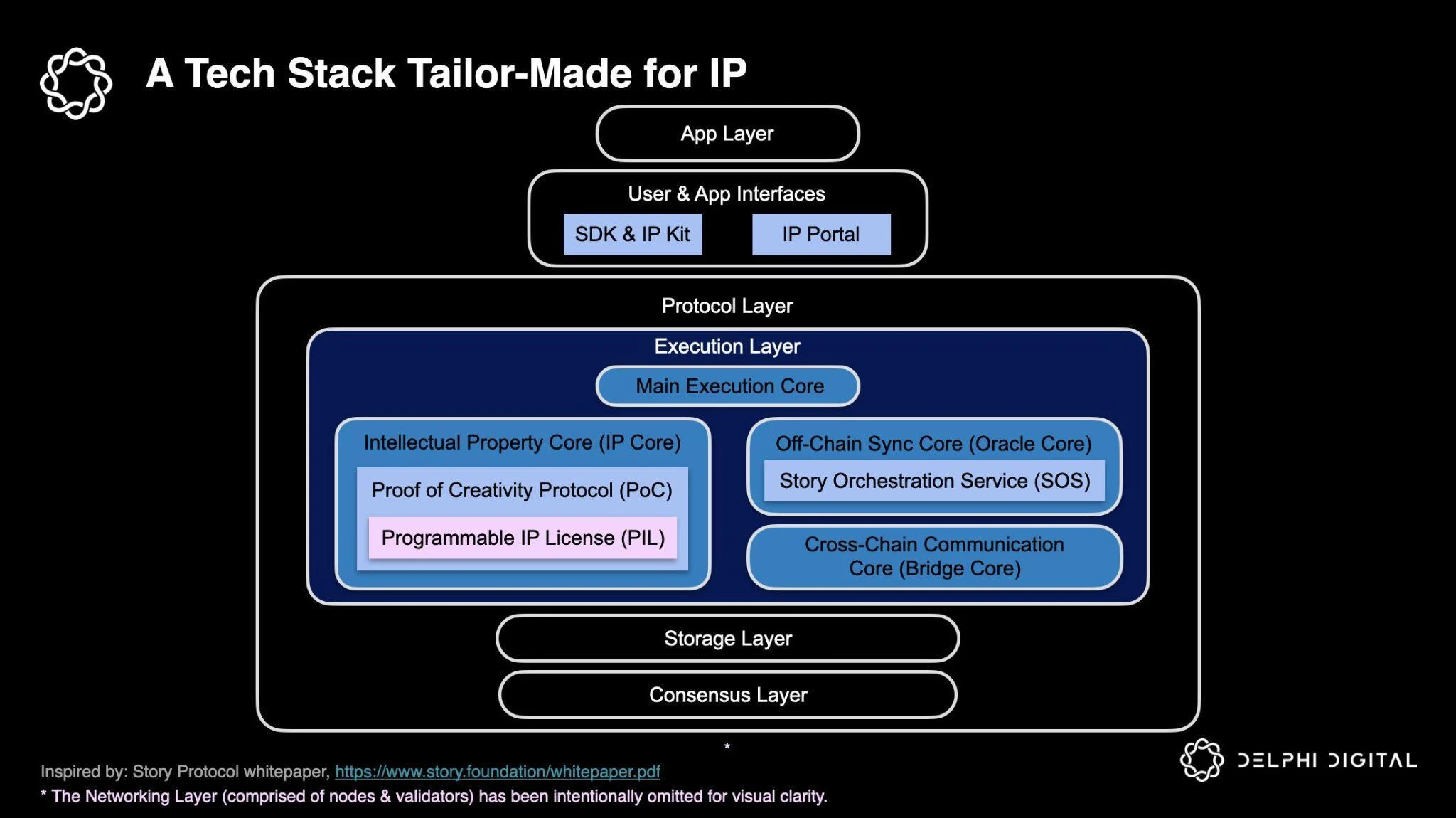
Together, these components form the technical backbone of Story Protocol, enabling it to provide an AI-native, composable, and compliance-friendly IP licensing system. Next, we will further disassemble how these systems work together to support a truly programmable IP economy.
3.1 Native IP Execution and Cross-Chain Interoperability
Storys architecture is designed to support highly unique and useful native IP features, such as:
Recursive licensing: License terms can be passed down through derivative works
Multi-hop royalty distribution: payment paths can span multiple layers of creator chains
Composable attribution tree: attribution chains are reusable, programmable, and scalable
Even on faster blockchains like Solana, handling royalty distribution for multiple layers of derivative works usually requires application-specific code and multiple on-chain data calls. This complexity and high cost are not what general public chains are good at optimizing. In contrast, Story natively supports these complex workflows from the bottom up, making remix, monetization, and attribution management more streamlined.
In order to extend these capabilities to off-chain ecosystems, Story has simultaneously built a powerful cross-chain interoperability mechanism. It uses Cosmos IBC protocol to achieve native communication within the Cosmos ecosystem, while integrating cross-chain message protocols such as LayerZero, deBridge, and Stargate to achieve broader multi-chain communication. This design allows IP assets to flow freely between different ecosystems, opening up space for IP liquidity, composability, and authorized use in DeFi applications, NFT platforms, and other crypto scenarios.
3.2 Connecting on-chain IP with real-world systems
To truly unleash the full potential of Programmable IP, Story has built a dedicated core module to directly connect on-chain IP assets with the off-chain world. Unlike traditional general-purpose oracles, Storys Off-Chain Synchronization Core focuses on the fine-grained interaction requirements required for IP workflows.
For example, when an independent artist licenses their digital work through Story, Story’s Orchestration Service (SOS) automatically performs off-chain identity authentication, links traditional payment channels to realize royalty collection, and generates legally binding authorization documents.
Although SOS provides a valuable set of off-chain features (including identity verification, legal document generation, and payment integration), there is currently no detailed technical documentation to explain how it works. For potential users, it is still a barrier to fully trust these off-chain services without being able to communicate directly with the team.
With this in mind, the table below outlines the differences between Story’s dedicated oracle framework and generic solutions in key IP processes.
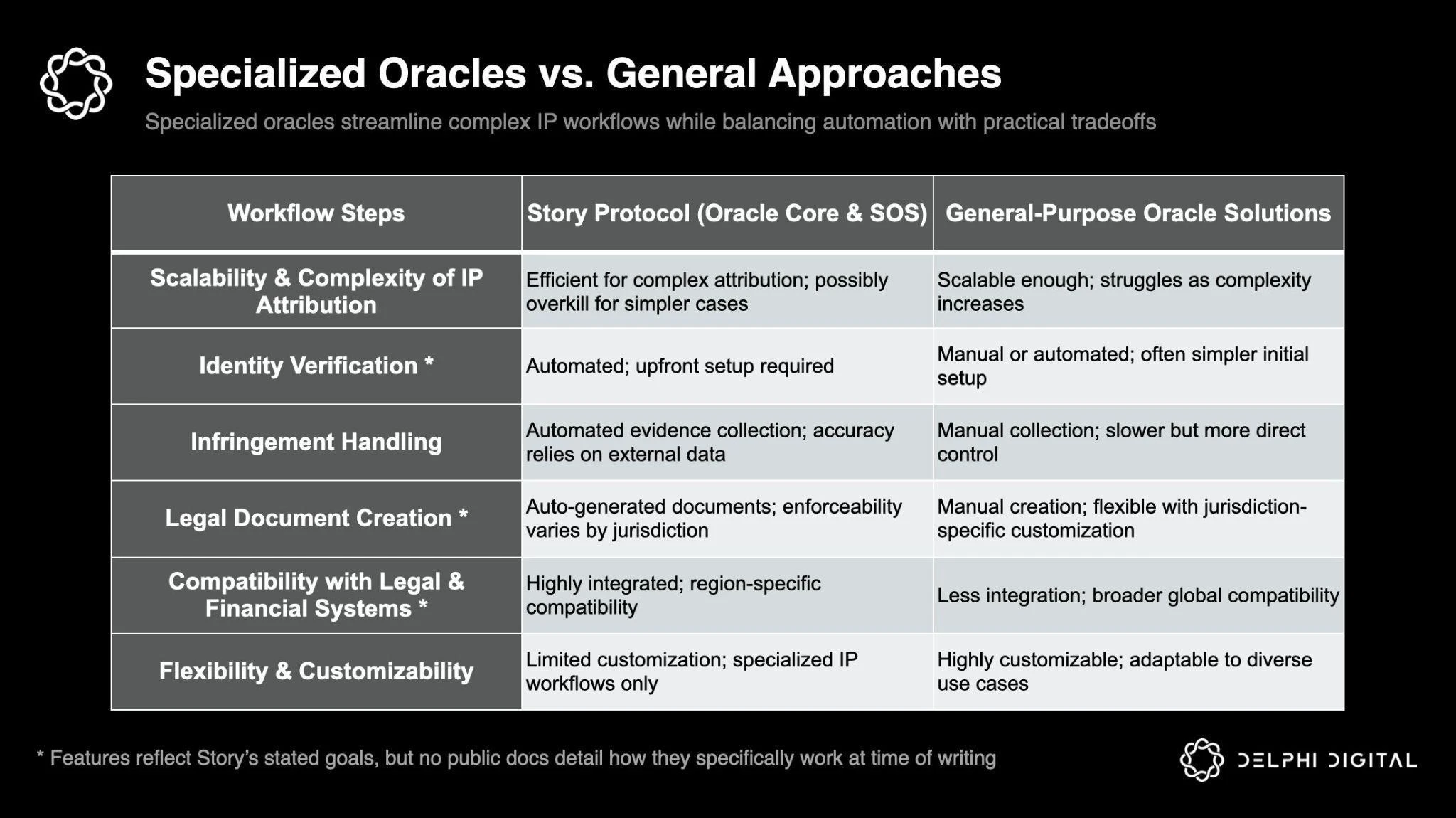
This targeted architecture is particularly useful in dealing with infringements and other scenarios. If an IP asset you registered in Story is used without authorization, SOS can automatically collect the necessary evidence off-chain and generate legally effective rights protection materials. This significantly improves the efficiency of infringement discovery and resolution, while reducing the administrative burden of collecting evidence, initiating lawsuits, and removing infringing content in traditional rights protection.
Technicians tend to overestimate the capabilities of their systems, especially when faced with the complexity of the real world. But in the case of Story, its design that combines traditional oracle logic with automated processes is the real core value. It builds an experience for users to smoothly connect off-chain needs with on-chain visions. Especially in the large number of transactions brought about by the wave of AI content, Story is expected to simplify management processes through automation, allowing creators and businesses to focus on creation, distribution and commercialization.
3.3 Proof of Creativity (PoC) and Programmable Institutional Licensing (PIL)
Storys core highlight, and the key to its continued differentiation, lies in the Proof of Creativity Protocol (PoC) and Programmable IP License (PIL).
As mentioned earlier, traditional IP systems are far behind the speed and complexity of contemporary knowledge creation. Especially in the context of AI being able to quickly generate large amounts of digital assets, it is difficult for humans to track content ownership in a timely manner.
The core of the PoC protocol is that every asset minted on the chain is automatically embedded with ownership, ownership and authorization information. This metadata on-chain storage itself is not new, but Story combines these metadata with a programmable authorization mechanism to achieve automated contracts and execution at the protocol layer, which is a first.
The following diagram shows the collaborative operation process of Storys various modules, and how to ensure that asset registration, ownership, and compliance authorization are not overwhelmed by AI-generated content on a large scale.

What’s really important about this approach is the practical effects it brings: automatic royalty distribution, transparent and auditable records, and self-executable licensing terms without manual supervision. Cooperation with many innovative companies also shows that Story provides not only a future vision, but also a set of current practical and commercial solutions.
Of course, there are still unknowns: Will the infringement complaint filed by Story be accepted by the court? Will its dispute resolution and proof mechanism be recognized and stable by the global legal system? These remain to be seen.
But what is certain is that Story has not shied away from the complex nature of the business it is involved in. If its operational efficiency and actual implementation effect are strong enough, PoC and PIL are entirely possible to become an important part of the new property rights order driven by AI. For now, Story has seized a real pain point that many non-crypto competitors have not yet solved with its precise approach and differentiated solutions.
3.4 User Interface and Developer Tools
The success of Story Protocol ultimately depends on its practicality rather than the elegance of its technology. In order to lower the barrier of entry for developers and non-technical users, Story provides two complementary interfaces:
Story SDK IP Kit: The SDK provides low-level access to Storys complete IP licensing stack, while the IP Kit abstracts complex operations into a standardized plug and play process. Just as Stripe enables small merchants to achieve a smooth payment experience without building payment infrastructure, the IP Kit enables developers to provide creators with a simple and consistent interface for registering, licensing, and monetizing IP without having to build the underlying logic from scratch.
IP Portal: A code-free interface that allows creators to manage their IP assets without deep cryptographic knowledge. This is particularly important for artists, studios, and rights holders who are accustomed to traditional workflows, helping to facilitate their smooth on-chaining.
The following is a screenshot of the IP Portal front-end interface:

Although Storys user interface is designed to be simple and intuitive, true usability still depends on whether these tools fit the real IP workflow. The above components together build a dedicated, IP-native infrastructure, which is the key difference between Story Protocol and general chains or platforms.
At present, more and more people in the crypto community are calling for attention to shift from duplicate infrastructure construction to building truly powerful application layer products to push the industry towards the broadband moment. In this context, the existence of Story seems particularly reasonable: it does not pursue basic layer construction in order to increase valuation, but provides a systematic solution to a real and increasingly serious problem.
In order to further understand why some business models can only be realized on Story, we will use specific cases to demonstrate the application value of Story in actual scenarios.
4. Practical implementation of programmable IP
Before we get into the case studies, here’s an overview of the general user experience differences between using and not using Stories:
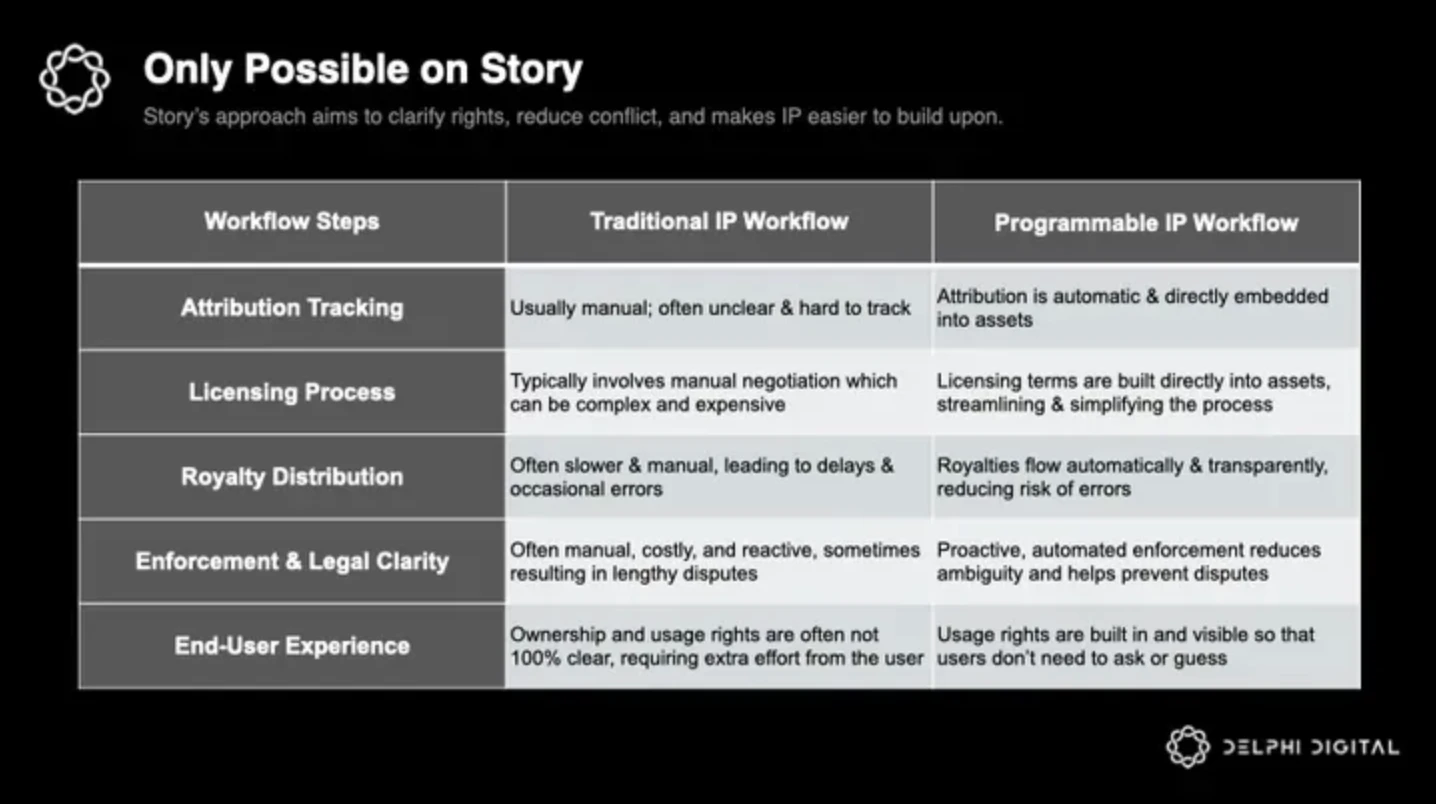
The next two cases show how Story is reshaping the creative and data-driven ecosystem, especially in areas where existing IP frameworks fail or are completely missing.
4.1 Magma – Protecting Artists’ Rights and Facilitating Creative Collaboration
Problem: Digital artists have always faced challenges in protecting the ownership of their works. The identification and tracking process of the source of creation is often informal, remix works are difficult to count, and income depends on the platform (intermediary) or manual authorization process. Once entering the collaborative creation scene, the ownership of rights becomes even more unclear.
Solution: Magma uses Story to embed licensing terms directly into every work registered and on-chain. Their 3 million users can set their own remix licensing scope, attribution tracking standards, and automatically execute royalty distribution mechanisms.
Practical impact: Artists can finally control how their works are used and earn income from derivative works. Collaborative creation in an environment protected by smart contracts is far more reliable and transparent than relying on platform policies to protect rights and interests.
4.2 Mahojin – Transparent AI with traceable value
Problem: In the current AI ecosystem, data providers and model builders generally lack effective infrastructure to claim data ownership, track model reuse, or participate in the distribution of the derived value. Data sets are often collected, adapted, and used to train models, but the original contributors are often not labeled and cannot receive any financial rewards - their efforts are evaporated in the black box training process.
Solution: Mahojin uses Story Protocol to register data sets and AI models as on-chain intellectual property assets (IP Assets) and embed usage terms and revenue rules in them. When a model is used for fine-tuning and generates revenue downstream, the protocol automatically distributes payments along the contribution chain without manual coordination.
Through this mechanism, every data set, every model parameter, and even every fine-tuning operation has verifiable traceability logic and value attribution. This not only improves industry transparency, but also makes data a programmable and liquid asset unit for the first time.**Actual impact: **In the past, once data entered the training process, it disappeared into a black box, lacking transparency, incentives or rewards. Mahojin gives data sets and models on-chain life through protocolization - they are no longer passive resources, but digital property rights that can autonomously participate in value circulation and obtain revenue sharing.
Under this mechanism:Model builders can embed incentive rules to achieve a fairer distribution of value;
Data providers can track the flow and use of their assets;
Downstream developers can also obtain clear authorization to avoid infringement disputes.
Mahojin has established an executable value chain for collaborative AI RD, making previously “invisible” contributions visible, traceable, and monetizable.
In the above cases, we can clearly see a common theme: Story Protocol is transforming the fragmented and manual IP management process into a programmable and executable systemic architecture.
It can:
Automatically complete the recording and identification of creation ownership;
Simplify complex authorization and licensing processes;
Royalties and revenues can be cleared and distributed without the need for an intermediary.
These capabilities are precisely the weakest and most dispute-prone parts of the traditional IP system.
As AI content creation and intelligent proxy systems gradually take over the production process, human collaboration alone is no longer enough. We need an IP infrastructure that can run normally without human coordination, and Story Protocol is building such a new paradigm.
The following chapters will further explore: When IP is no longer just “recordable information” but is directly embedded in the behavioral logic of intelligent agents, how will the Story model take root in an AI-native environment?
5. Rethinking IP coordination at machine scale
Story Protocol introduces two ambitious foundational mechanisms to provide structural support for IP collaboration in AI-native environments: Chain of Intelligence and Agent TCP/IP. The former is used to establish executable economic and legal relationships between data sets, models, and generated content, while the latter empowers agents to authorize, trade, and execute IP protocols autonomously with little human intervention. Together, these two systems build a new machine-native IP infrastructure whose core feature is that both value transfer and rights enforcement are completed at the protocol layer. However, their performance at large scale remains to be verified.
5.1 Smart Chain: Attribution Tracking Mechanism in AI Pipeline
Generative AI systems increasingly rely on layers of asset relationships: data sets train basic models, which are then fine-tuned into specialized models, which generate content, which in turn may become training inputs for the next generation of systems. In such a dynamic pipeline, how to accurately track and properly incentivize upstream contributors becomes technically complex and economically critical.
Story attempts to provide a systematic solution to this problem by encoding usage rights and royalty terms directly into each asset. As derivative models or output content generate revenue, the protocol automatically distributes the proceeds back to the entire contributing network based on the authorization logic, achieving cross-chain value reflux.
Example: Dataset A is used to train model B, model B is fine-tuned into model C, and model C generates content D. When content D generates revenue, the protocol will distribute the revenue to the contributors of dataset A, model B, and model C according to the preset programmable licensing terms.
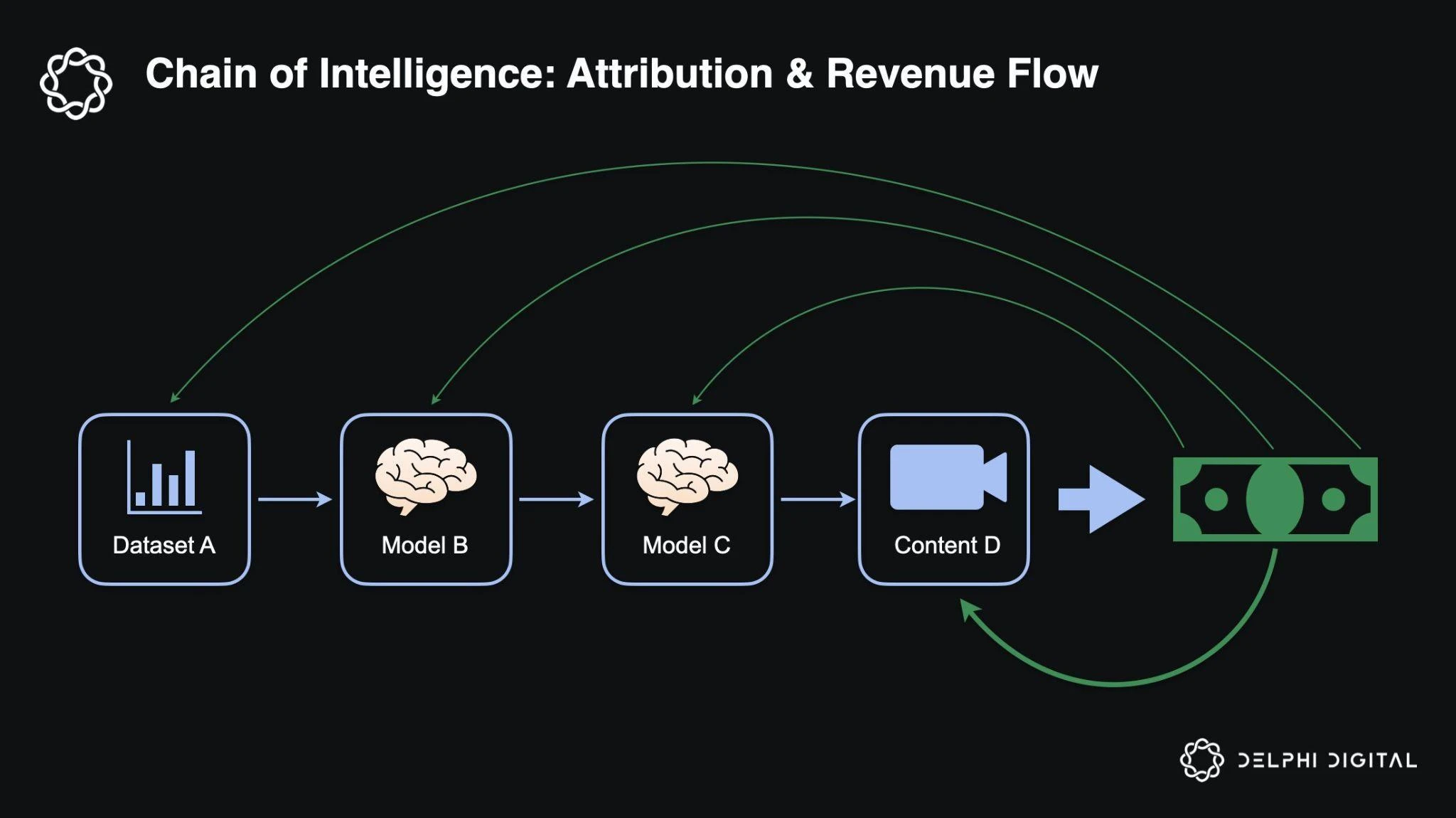
Developers can register datasets and models through Storys SDK and API. Story Attestation Service is also integrated into IP Portal to compare generated prompts and results with registered IP, thereby marking potential abuse and ensuring that IP owners and contributors receive corresponding signatures and revenue shares. To support this machine-scale licensing flow, Story plans to launch a specially optimized AI native execution core to handle high-throughput licensing computing needs.
5.2 Proxy IP Business: Protocol Toolkit for Enhanced Autonomy
Agent TCP/IP, launched by Story, aims to provide agents with a complete set of autonomous tools that enable them to negotiate licensing terms, execute complex transactions, and fulfill agreements with little to no real-time human intervention. Interactions between agents are achieved through structured rounds of negotiations and managed by smart contracts. The standardized interaction structure allows agents to repeatedly propose terms, make counter-offers, modify details, and continuously forge licensing drafts in the process, ensuring that the entire negotiation process has clear on-chain records and traceability.
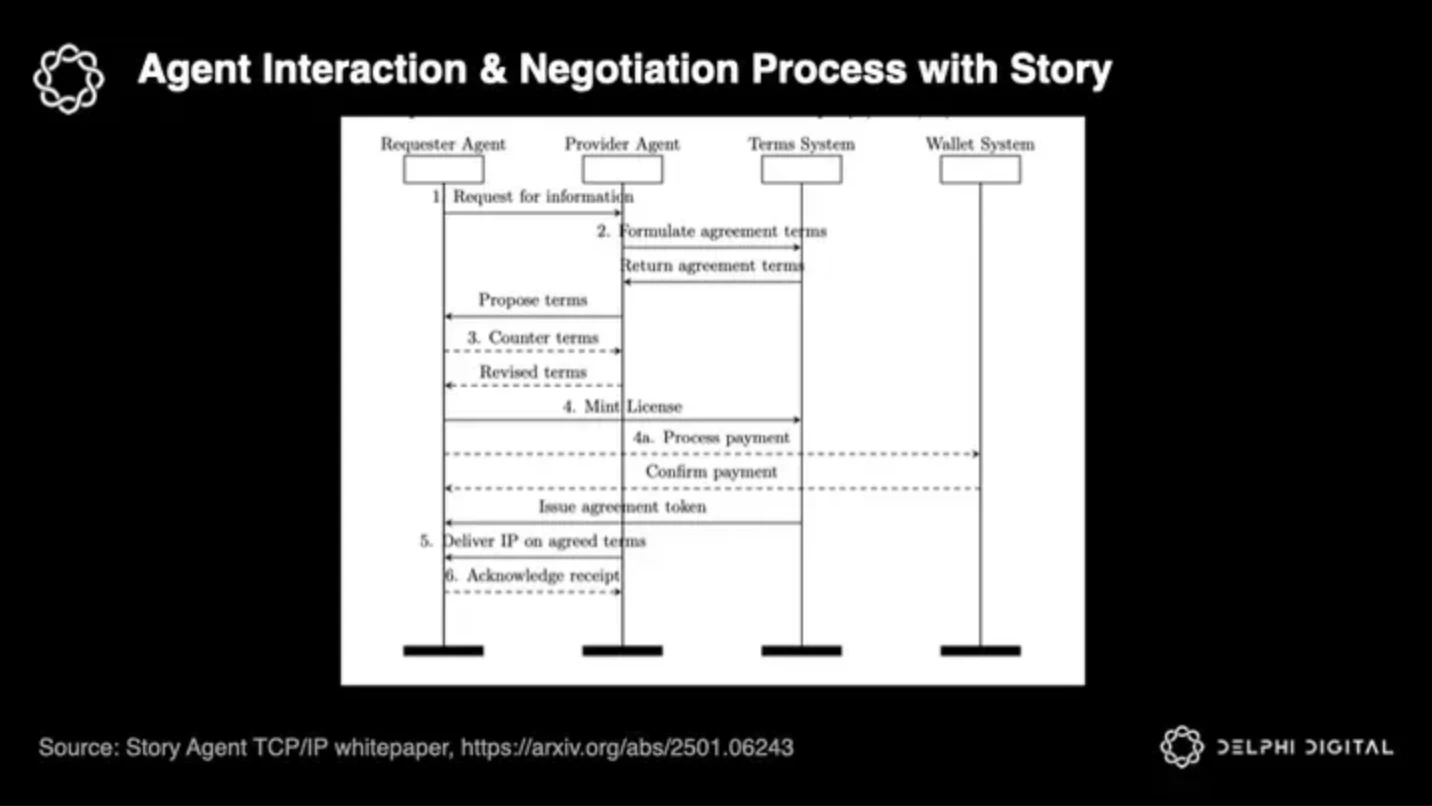
To participate in the network, agents must stake $IP tokens and face token penalties or reputational losses when using unauthorized assets. These designs are intended to strengthen incentive alignment and ensure that the entire protocol remains compliant, reliable, and secure even with a high degree of autonomy for agents.
Example: A weather forecast agent automatically initiates a licensing negotiation with a dataset provider agent through the Story protocol. The dataset agent initially proposes terms that include an advance payment and ongoing royalties. The weather agent uses the negotiation tools provided by Story to adjust the royalty ratio and payment timing. In each round of negotiation, the agent records the proposed terms as a draft authorization on the chain. Finally, when the two parties reach an agreement, the system mints the agreement into a binding authorization token. The income from future weather forecasts will be automatically returned to the original dataset party according to the terms. The entire negotiation process leaves a clear and auditable record on the chain.
Compared with general-purpose chains, Story’s advantage lies in its deep vertical integration in negotiation, coordination, and compliance. This type of dedicated architecture is particularly critical for intelligent ecosystems that rely on complex, multi-round interactions, especially in scenarios where human supervision is difficult to scale.
6. $IP Token
$IP is the core token that drives the Story Protocol ecosystem and is used to fund protocol development, community operations, and contributor incentives. More than 58% of the 1 billion tokens initially issued are explicitly used for the above purposes. Tokens for early supporters and core teams will begin to be unlocked in mid-February 2025 and will be gradually released over the next 40 months.
6.1 Token Allocation
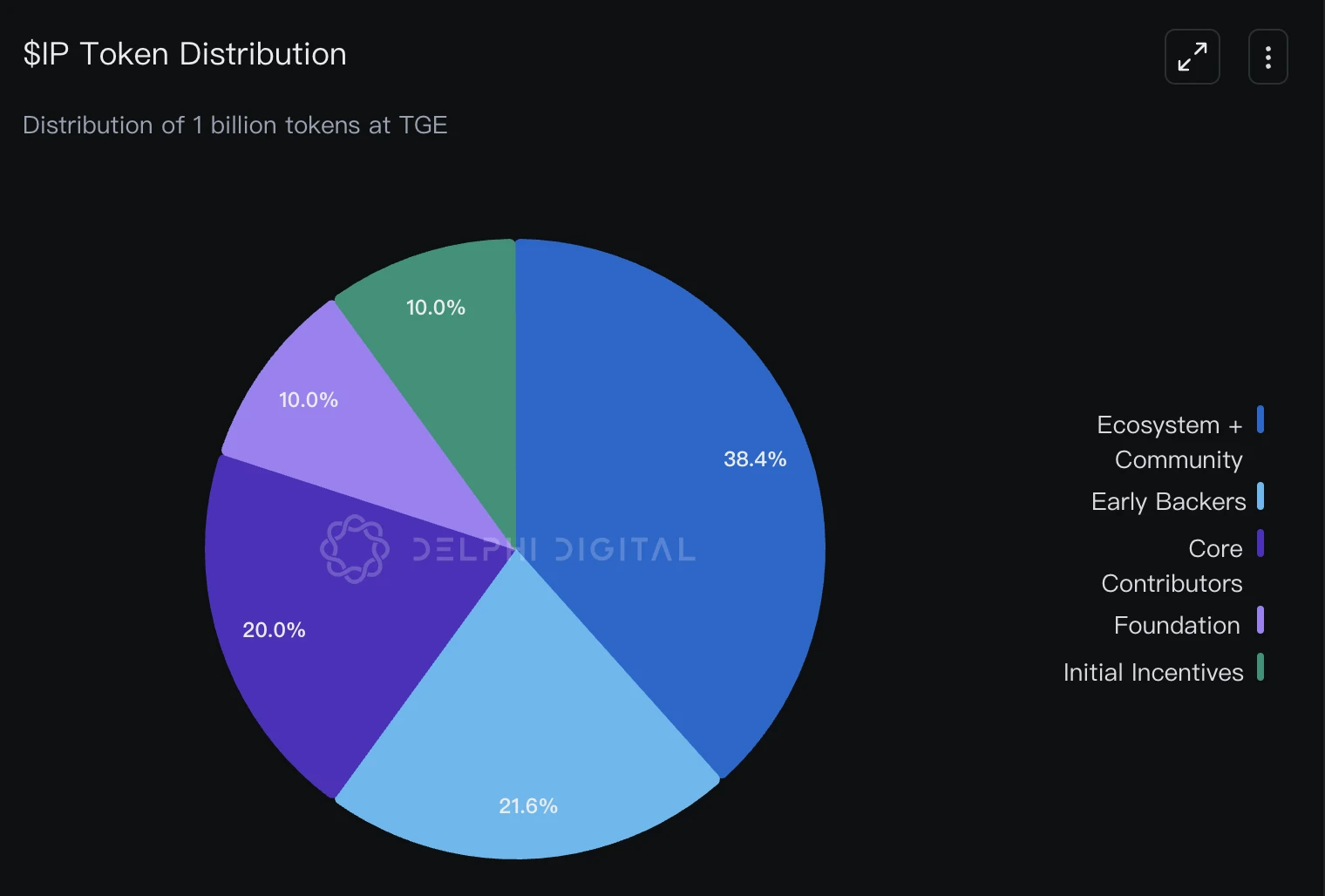
7. Logical Verification
Story Protocol proposes an ambitious programmable IP infrastructure model. However, no matter how well the architecture is designed, it is difficult to avoid the friction and risks in the real world. If we want to test its long-term vitality, we must put this theory under a high-pressure environment for a substantial stress test.
7.1 Legal and regulatory risks
Storys PIL (Programmable Licensing) greatly simplifies the complex IP process, but innovation itself does not mean that it can be accepted by the existing legal system. At present, the authorization mechanism based on encryption technology has hardly been substantively tested in courts around the world, and its legal enforceability remains unknown. To make matters more complicated, different jurisdictions have significant differences in their attitudes and regulations towards new technologies, and global compliance expansion faces practical obstacles.
At the same time, in patent-based IP markets such as biotechnology or closed-source software, the deep involvement of AI also makes the determination of invention ownership full of uncertainty. Regulatory agencies and patent offices in various countries are still discussing how to define the role of AI in the innovation process, and the combination of encryption and AI, two cutting-edge technologies, has exacerbated the complexity of cross-regional applicability.
For example:
Germany’s eIDAS regulatory system has extremely strict verification standards for electronic identities and records. If a court finds that blockchain records fail to meet its verifiability standards, Story’s on-chain license could be deemed invalid in an infringement case, especially in patent scenarios where AI-generated innovations frequently appear.
Singapore has explicitly supported crypto transactions through the Payment Services Act . This more open attitude allows Story’s framework to be more naturally integrated into local compliance businesses, opening up a convenient channel for its application.
The above examples clearly show that the same technology may be unimpeded or difficult to implement in different markets. Although Story’s open design lowers the entry barrier, it still needs to be precisely connected at the local regulatory level in order to achieve global scale implementation.
For programmable licensing to be widely accepted, Story needs courts, regulators, and rights holders to build trust in it. This requires not only clear judicial precedents, but also in-depth education and ecological collaboration. Otherwise, cultural suspicion and procedural delays may slow down the pace of actual application of the protocol.
This map reveals the global gap between public awareness and legislative action on emerging technologies such as AI:
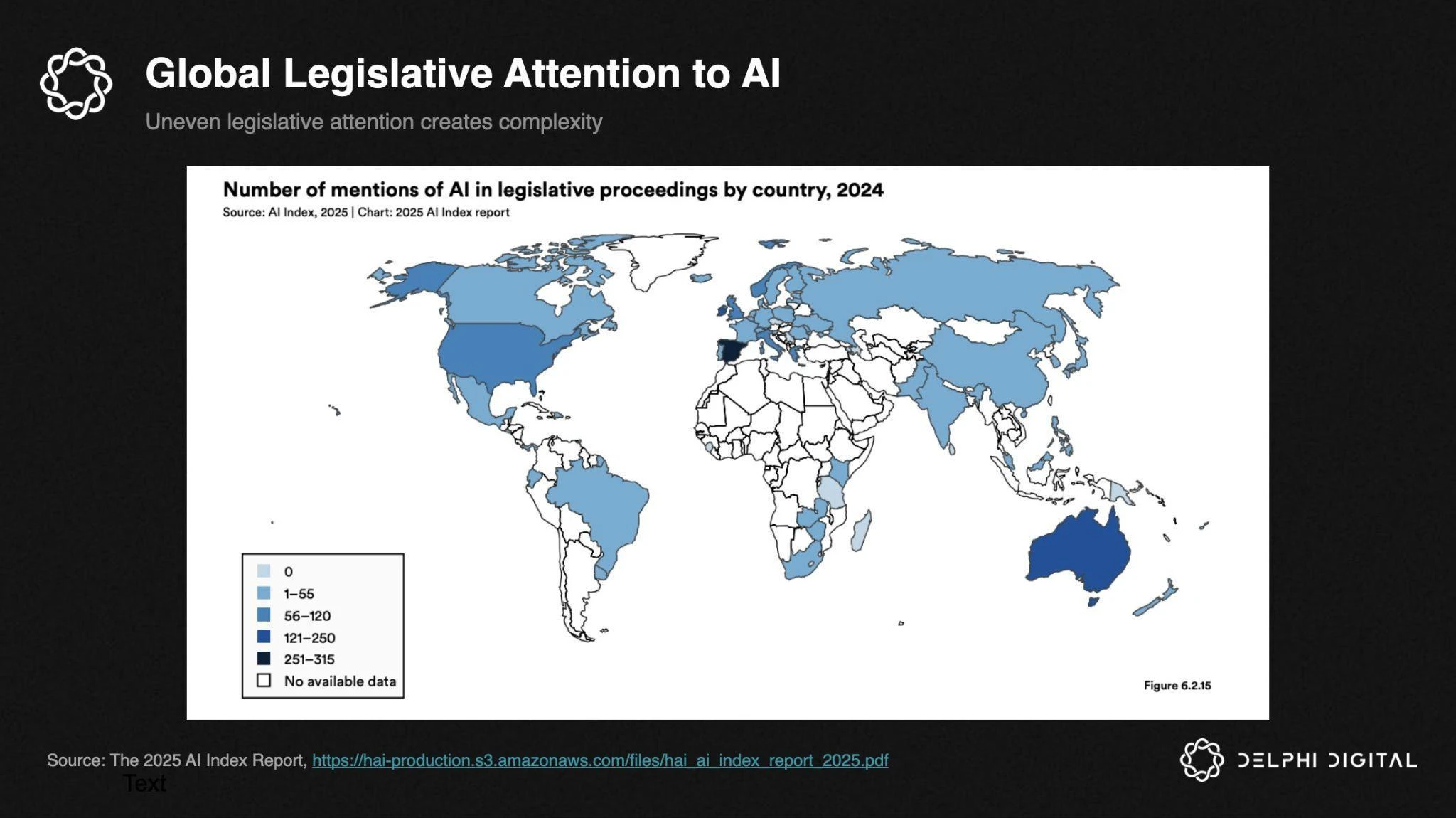
7.2 AI-related structural risks
The explosive growth of AI content and innovation is challenging the existing IP framework in all aspects. From artworks to algorithm patents, from scientific breakthroughs to generative code, AIs creative ability makes rights ownership unclear and makes the economic value distribution mechanism more difficult to operate.
Storys Proof of Creativity intends to address this dilemma through on-chain registration and traceability, systematically tracking the source of content, derivative relationships, and revenue attribution. However, whether this mechanism can truly support the huge scale and complexity required by AI remains an open question. Once attribution traceability becomes unfeasible, or its economic incentives are no longer realistic, the foundation of the Story protocol may be shaken.
Especially in fields that are highly dependent on AI, such as drug design and diagnostic algorithms, the involvement of AI will greatly blur the boundaries between original and joint invention. If the court ultimately determines that AI inventions lack attributability or that they borrow too much from existing innovations, not only will Storys positioning be challenged, but the economic foundation of the entire patent system may also be shaken.
As @lex_node pointed out, this is not only a crisis of IP law, but may also touch upon a deeper uncomfortable proposition: in a future dominated by AI, will the meaning of intellectual property rights or even property itself still hold true?
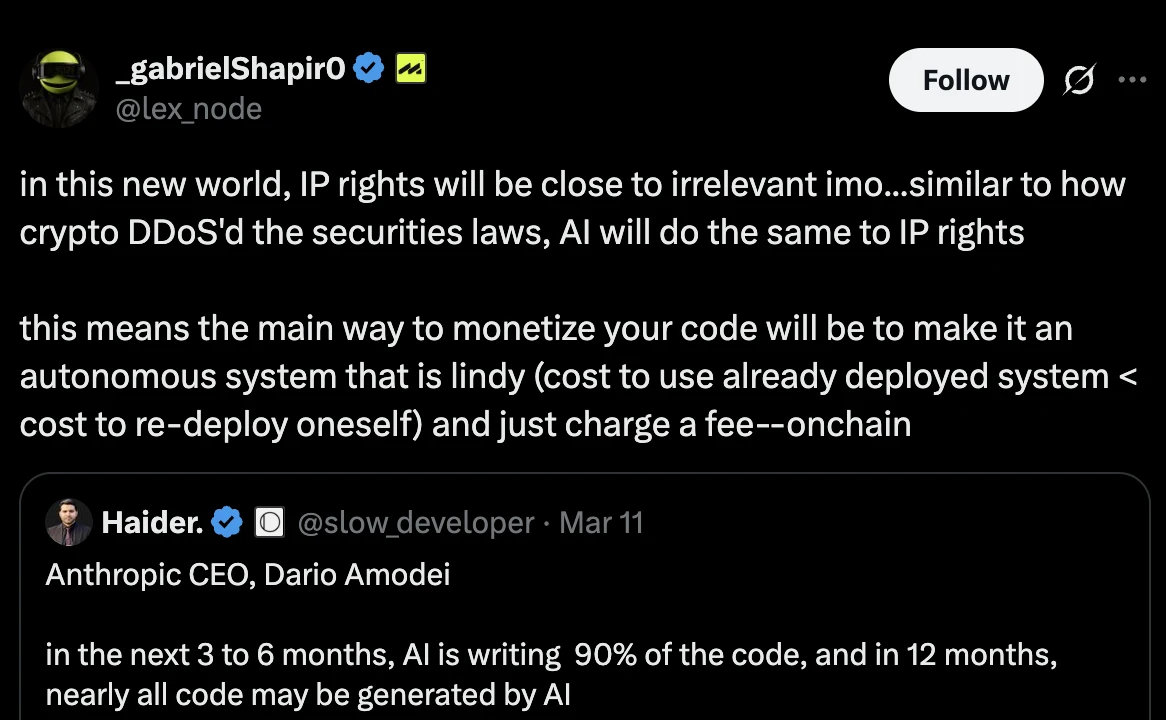
7.3 Adoption and Integration Risks
Although Storys technical architecture is designed for IP scenarios and is highly innovative, it also means that it may face higher barriers to user adoption and platform integration.
Compared with traditional IP registration and management systems, Storys programmable authorization and automatic attribution tracking tools may be relatively unfamiliar to users in the early stages, and the learning cost is relatively high. If its interface design and on-boarding experience cannot be extremely intuitive, even if it has obvious technical advantages, users may still choose to continue using centralized platforms that are simpler to operate.
In addition, how Story handles infringement detection remains an unsolved problem. Artistic creation is naturally affected by style, subject matter, and composition. If a creators style is similar to Hayao Miyazaki, is it a tribute or infringement? Can Storys proof of creativity mechanism effectively identify such subtle differences? If the system cannot accurately distinguish between borrowing and plagiarism, then creators may hesitate to use Story due to uncertainty.
Furthermore, mainstream IP owners (such as well-known artists, research institutions, universities, etc.) usually prefer a robust and credible system. If Story cannot clearly demonstrate the actual benefits it brings (such as cost reduction or revenue increase), its initial popularization will face structural resistance.
Story is aware of the above challenges and has therefore adopted an active incubation strategy to provide technical support, market guidance and resource linkage to early ecological projects. This approach is different from spending money support and focuses more on the deep binding and synergy between projects and protocols.
In an increasingly competitive on-chain ecosystem, attention and liquidity are essentially scarce resources. If Story wants to retain developers and users, it must develop a batch of native applications that can only be implemented on Story.

7.4 Challenges in the competitive landscape
The real competition that Story faces comes from three types of mature systems: traditional IP framework, digital rights management (DRM) system and general public chain.
Traditional IP systems: Still dominant in terms of legal enforcement and industry trust, despite their poor support for dynamic licensing and content derivation.
DRM platforms (such as Adobe): have been widely adopted. Although they lack flexibility and openness, their stability and compliance still constitute natural advantages.
High-performance chains (such as Solana): Although not designed specifically for IP, they have a complete development ecosystem and can provide sufficient IP tools with low barriers to entry and high acceptance.
If Story cannot clearly convey its “irreplaceable” core value to the market, its technological advantages may be misunderstood as “over-design” or “complexity”.
Therefore, positioning, usability and narrative clarity are not icing on the cake, but the core variables that determine whether Story can deliver on its ambitions.
8. A rational bet on Story Protocol
Story Protocol proposes an exciting vision: to reconstruct the IP management system in the AI era. Instead of trying to patch the loopholes of the traditional system, it takes a different approach and builds a dedicated underlying chain to fundamentally solve key problems such as attribution confirmation, revenue distribution and programmable licensing - which are the most vulnerable parts of the current system. Storys innovation lies in that it embeds compliance directly into the protocol layer, thereby bridging the Web3 native architecture with the real-world legal environment. This technical design reflects a deep consideration of actual enforceability and legal feasibility, and also makes it potentially a hub component connecting the on-chain world with real-world IP practices.
However, this exclusive chain model also inevitably brings some challenges. Compared with those more general and familiar mainstream chains or platforms, Storys architecture has certain trade-offs in terms of adoption barriers, integration complexity and user experience. Ultimately, Storys success depends on whether it can clearly and powerfully communicate its unique value and demonstrate in practice:
Simple and intuitive usability;
Deep and authentic creator participation;
Quantifiable operational and revenue advantages.
Despite these challenges, Story Protocol still shows real potential for the future, especially in the current era of unlimited AI content and blurred boundaries of creativity. Storys mission is not only to solve copyright issues, but also to protect those forms of expression that have the core of human emotion and creativity from being overwhelmed by empty content generated by algorithms.
If Story can win trust and make substantial progress in the ecosystem it serves, it will not only have the potential to reshape the global IP coordination system, but will also become an important infrastructure supporting a new Internet that is “people-centric and value-clear.”
The enemy is everywhere, and in countless futures they have won. But I see a way out... There is a narrow passage.
—Paul Atreides, Dune 2 (2024)










